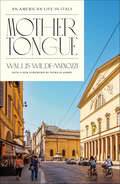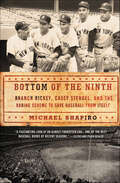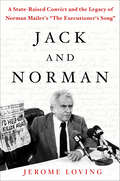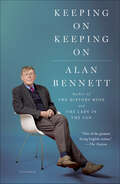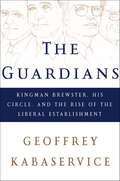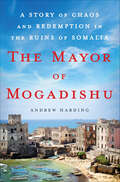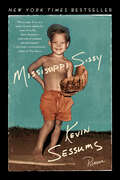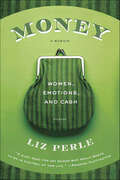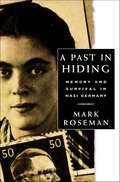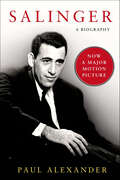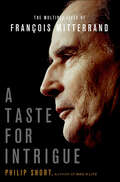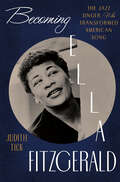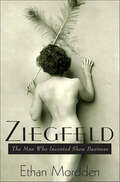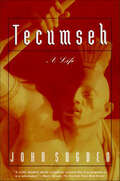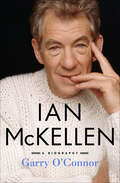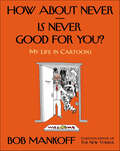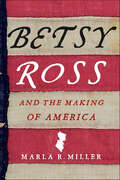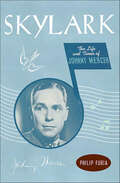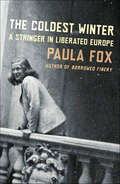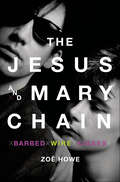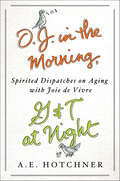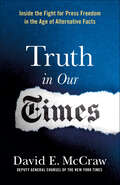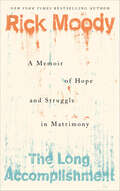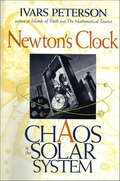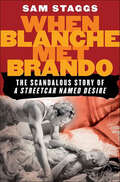- Table View
- List View
Mother Tongue: An American Life in Italy
by Wallis Wilde-MenozziA probing and poetic examination of language, food, faith, and family attachment in Italian life through the eyes of an American who moved to Parma with her husband and family. In the 1980s, the American writer Wallis Wilde-Menozzi moved permanently with her Italian husband and her daughter to Parma, a sophisticated city in northern Italy, where he became a professor of biology. Her search for rootedness in the city that was to be her home introduced her to complexities in her identity as she migrated into another language and looked for links beyond the joys of Verdi, Correggio, and Parmesan cheese, which visitors have rightly extolled for centuries. The local resistance to change perceived as individualistic led Wilde-Menozzi to explore the pull and challenge of difference and discover the backbone she needed for artistic freedom. In Mother Tongue, Wilde-Menozzi offers stories of far-sighted lives, remarkable Parma men and remarkable women, including the Renaissance abbess Giovanna Piacenza, the fighting Donella Rossi Sanvitale, and her own indefatigable mother-in-law. Framed with a new introduction by the author, and a new foreword by Patricia Hampl, this classic on diversity and tolerance, family, faith, and food in Italy and the United States is at once timeless and timely, a “large, beautiful window into the intelligent, literate, reflective life of Italy” (Shirley Hazzard).
Bottom of the Ninth: Branch Rickey, Casey Stengel, and the Daring Scheme to Save Baseball from Itself
by Michael ShapiroIn Bottom of the Ninth, Michael Shapiro brings to life a watershed moment in baseball history, when the sport was under siege in the late 1950s "A fascinating look at an almost forgotten era . . . One of the best baseball books of recent seasons." -Cleveland Plain DealerShapiro reveals how the legendary executive Branch Rickey saw the game's salvation in two radical ideas: the creation of a third major league—the Continental League—and the pooling of television revenues for the benefit of all. And Shapiro captures the audacity of Casey Stengel, the manager of the Yankees, who believed that he could remake how baseball was played.The story of their ingenious schemes—and of the powerful men who tried to thwart them—is interwoven with the on-field drama of pennant races and clutch performances, culminating in the stunning climax of the seventh game of the 1960 World Series, when one swing of the bat heralds baseball's eclipse as America's number-one sport.
Jack and Norman: A State-Raised Convict and the Legacy of Norman Mailer's "The Executioner's Song"
by Jerome LovingThis is the story of an author and his apprentice. It is the story of literary influence and tragedy. It is also the story of incarceration in America.Norman Mailer was writing The Executioner’s Song, his novel about condemned killer Gary Gilmore, when he struck up a correspondence with Jack Henry Abbott, Federal Prisoner 87098-132. Over time, Abbott convinced the famous author that he was a talented writer who deserved another chance at freedom. With letters of support from Mailer and other literary elites of the day, Abbott was released on parole in 1981. With Mailer’s help, Abbott quickly became the literary “it boy” of New York City. But in a shocking turn of events, the day before a rave review of Abbott’s book, In the Belly of the Beast, appeared in TheNew York Times, Abbott murdered a New York City waiter and fled to Mexico. Eerily, like Gary Gilmore in Mailer’s true-life novel, Abbott killed within six weeks of his release from prison. Now Jerome Loving explores the history of two of the most infamous books of the past 50 years, a fascinating story that has never before been told.
Keeping On Keeping On
by Alan BennettA collection of Bennett’s diaries and essays, covering 2005 to 2015Alan Bennett’s third collection of prose, Keeping On Keeping On, follows in the footsteps of the phenomenally successful Writing Home and Untold Stories. Bringing together the hilarious, revealing, and lucidly intelligent writing of one of England’s best-known literary figures, Keeping On Keeping On contains Bennett’s diaries from 2005 to 2015—with everything from his much celebrated essays to his irreverent comic pieces and reviews—reflecting on a decade that saw four major theater premieres and the films of The History Boys and The Lady in the Van. A chronicle of one of the most important literary careers of the twentieth century, Keeping On Keeping On is a classic history of a life in letters.
The Guardians: Kingman Brewster, His Circle, and the Rise of the Liberal Establishment
by Geoffrey KabaserviceHow liberalism and one of the most dramatic eras in American history were shaped by an influential university president and his powerful circle of friendsYale's Kingman Brewster was the first and only university president to appear on the covers of Time and Newsweek, and the last of the great campus leaders to become an esteemed national figure. He was also the center of the liberal establishment—a circle of influential men who fought to keep the United States true to ideals and extend the full range of American opportunities to all citizens of every class and color. Using Brewster as his focal point, Geoffrey Kabaservice shows how he and his lifelong friends—Kennedy adviser McGeorge Bundy, Attorney General and statesman Elliot Richardson, New York mayor John Lindsay, Bishop Paul Moore, and Cyrus Vance, pillar of Washington and Wall Street—helped usher this country through the turbulence of the 1960s, creating a legacy that still survives. In a narrative that is as engaging and lively as it is meticulously researched, The Guardians judiciously and convincingly reclaims the importance of Brewster and his generation, illuminating their vital place in American history as the bridge between the old establishment and modern liberalism.
The Mayor of Mogadishu: A Story of Chaos and Redemption in the Ruins of Somalia
by Andrew Harding"This is a triumph of a book: surprising, informative, and humane." —Alexander McCall Smith"Stunning." —Foreign Affairs"Pieces together Nur's astonishing biography and follows him when he became mayor in 2010 and tried to restore confidence and bring back investment to the battered Somali capital." —NPR“Part on-the-ground war reporting, part investigative biography, Harding’s book captures both the fragile hopes and the appalling violence of Somalia . . . .” —The New York Times**A Foreign Affairs Best Book of 2017****One of Book Concierge's Best Books of 2016**In The Mayor of Mogadishu, one of the BBC’s most experienced foreign correspondents, Andrew Harding, reveals the tumultuous life of Mohamoud “Tarzan” Nur - an impoverished nomad who was abandoned in a state orphanage in newly independent Somalia, and became a street brawler and activist. When the country collapsed into civil war and anarchy, Tarzan and his young family became part of an exodus, eventually spending twenty years in north London.But in 2010 Tarzan returned, as Mayor, to the unrecognizable ruins of a city now almost entirely controlled by the Islamist militants of Al Shabab. For many in Mogadishu, and in the diaspora, Tarzan became a galvanizing symbol of courage and hope for Somalia. But for others, he was a divisive thug, who sank beneath the corruption and clan rivalries that continue, today, to threaten the country’s revival.The Mayor of Mogadishu is a rare an insider’s account of Somalia’s unraveling, and an intimate portrayal of one family’s extraordinary journey.
Mississippi Sissy
by Kevin SessumsMississippi Sissy is the stunning memoir from Kevin Sessums, a celebrity journalist who grew up scaring other children, hiding terrible secrets, pretending to be Arlene Frances and running wild in the South.As he grew up in Forest, Mississippi, befriended by the family maid, Mattie May, he became a young man who turned the word "sissy" on its head, just as his mother taught him. In Jackson, he is befriended by Eudora Welty and journalist Frank Hains, but when Hains is brutally murdered in his antebellum mansion, Kevin's long road north towards celebrity begins. In his memoir, Kevin Sessums brings to life the pungent American south of the 1960s and the world of the strange little boy who grew there."Kevin Sessums is some sort of cockeyed national treasure.” —Michael Cunningham
Money, a Memoir: Women, Emotions, and Cash
by Liz PerleA bold and personal book that digs below the surface of one of society's last taboos-money-and illuminates how women's emotional relationship with it affects every part of their lives Long ago, and not entirely consciously, Liz Perle made a quiet contract with cash: she would do what it took to get it-work hard, marry right-but she didn't want to have to think about it too much. The subject of money had, since childhood, been quietly sidestepped, a shadowy factor whose private influence was impolite to discuss. This deliberate denial eventually exacted its price, however, when a sudden divorce left Perle with no home, no job, and a four-year-old with a box of toys. She realized she could no longer afford to leave her murky and fraught relationship with money unexamined. What Perle discovered as she reassembled her life was that almost every woman she knew also subscribed to this strange and emotional code of discretion-even though it laced through their relationships with their parents, lovers, husbands, children, friends, co-workers, and communities. Women who were all too willing to tell each other about their deepest secrets or sexual assets still kept mum when it came to their financial ones. In Money, A Memoir, Perle attempts to break this silence, adding her own story to the anecdotes and insights of psychologists, researchers, and more than 200 "ordinary" women. It turned out that when money was the topic, most women needed permission to talk. The result is an insightful, unflinching look at the once subtle and commanding influence of money on our every relationship.
A Past in Hiding: Memory and Survival in Nazi Germany
by Mark RosemanA heart-stopping survivor story and brilliant historical investigation that offers unprecedented insight into daily life in the Third Reich and the Holocaust and the powers and pitfalls of memory.At the outbreak of World War II, Marianne Strauss, the sheltered daughter of well-to-do German Jews, was an ordinary girl, concerned with studies, friends, and romance. Almost overnight she was transformed into a woman of spirit and defiance, a fighter who, when the Gestapo came for her family, seized the moment and went underground. On the run for two years, Marianne traveled across Nazi Germany without papers, aided by a remarkable resistance organization, previously unknown and unsung. Drawing on an astonishing cache of documents as well as interviews on three continents, historian Mark Roseman reconstructs Marianne's odyssey and reveals aspects of life in the Third Reich long hidden from view. As Roseman excavates the past, he also puts forward a new and sympathetic interpretation of the troubling discrepancies between fact and recollection that so often cloud survivors' accounts.A detective story, a love story, a story of great courage and survival under the harshest conditions, A Past in Hiding is also a poignant investigation into the nature of memory, authenticity, and truth.
Salinger: A Biography
by Paul AlexanderJ.D. Salinger was one of the twentieth century's greatest writers. He was also one of its most elusive. After making his mark on the American literary scene, Salinger retreated to a small town in New Hampshire where he hoped to hide his life away from the world. With dogged determination, however, journalist and biographer Paul Alexander captured Salinger's story in this, the only complete biography of Holden Caulfield's creator published to date. Using the archives at Princeton, Yale, Harvard, Columbia, NYU and the New York Public Library as well as research in New York and New Hampshire, Alexander has created a great biography of Salinger that's further enriched by interviews with some of the greatest literary figures of our time: George Plimpton, Gay Talese, Ian Hamilton, Harold Bloom, Roger Angell, A. Scott Berg, Robert Giroux, Ved Mehta, Gordon Lish and Tom Wolfe.
A Taste for Intrigue: The Multiple Lives of François Mitterrand
by Philip ShortThe man who changed the course of modern FranceIn 1981, François Mitterrand became France's first popularly elected socialist president. By the time he completed his mandate, he had led the country for 14 years, longer than any other French head of state in modern times. Mitterrand mirrored France in all its imperfections and tragedies, its cowardice and glory, its weakness and its strength.In the wake of the Observatory affair (in which he orchestrated his own assassination attempt), his secretiveness and mistrust grew more pronounced, especially when details of a second family came to light; he was a mixture of "Machiavelli, Don Corleone, Casanova and the Little Prince," said his doctor.During the German occupation, Mitterrand hedged his bets by joining Petain's Vichy government. Later in 1943, under the nom de guerre of Morland (and 30 other aliases), Mitterrand quit Vichy for the Resistance and a paramilitary organization.He changed the ground rules of French social and political debate in ways more far-reaching and fundamental than any other modern leader before him, helping set the agenda for France and Europe for generations to come. Philip Short's A Taste for Intrigue will fill the gap and become the standard against which all other Mitterrand biographies are set.
Becoming Ella Fitzgerald: The Jazz Singer Who Transformed American Song
by Judith TickAn NPR 2023 "Books We Love" Pick • A Kirkus Best Nonfiction Book of 2023 A landmark biography that reclaims Ella Fitzgerald as a major American artist and modernist innovator. Ella Fitzgerald (1917–1996) possessed one of the twentieth century’s most astonishing voices. In this first major biography since Fitzgerald’s death, historian Judith Tick offers a sublime portrait of this ambitious risk-taker whose exceptional musical spontaneity made her a transformational artist. Becoming Ella Fitzgerald clears up long-enduring mysteries. Archival research and in-depth family interviews shed new light on the singer’s difficult childhood in Yonkers, New York, the tragic death of her mother, and the year she spent in a girls’ reformatory school—where she sang in its renowned choir and dreamed of being a dancer. Rarely seen profiles from the Black press offer precious glimpses of Fitzgerald’s tense experiences of racial discrimination and her struggles with constricting models of Black and white femininity at midcentury. Tick’s compelling narrative depicts Fitzgerald’s complicated career in fresh and original detail, upending the traditional view that segregates vocal jazz from the genre’s mainstream. As she navigated the shifting tides between jazz and pop, she used her originality to pioneer modernist vocal jazz. Interpreting long-lost setlists, reviews from both white and Black newspapers, and newly released footage and recordings, the book explores how Ella’s transcendence as an improvisor produced onstage performances every bit as significant as her historic recorded oeuvre. From the singer’s first performance at the Apollo Theatre’s famous “Amateur Night” to the Savoy Ballroom, where Fitzgerald broke through with Chick Webb’s big band in the 1930s, Tick evokes the jazz world in riveting detail. She describes how Ella helped shape the bebop movement in the 1940s, as she joined Dizzy Gillespie and her then-husband, Ray Brown, in the world-touring Jazz at the Philharmonic, one of the first moments of high-culture acceptance for the disreputable art form. Breaking ground as a female bandleader, Fitzgerald refuted expectations of musical Blackness, deftly balancing artistic ambition and market expectations. Her legendary exploration of the Great American Songbook in the 1950s fused a Black vocal aesthetic and jazz improvisation to revolutionize the popular repertoire. This hybridity often confounded critics, yet throughout the 1970s and 1980s, Ella reached audiences around the world, electrifying concert halls, and sold millions of records. A masterful biography, Becoming Ella Fitzgerald describes a powerful woman who set a standard for American excellence nearly unmatched in the twentieth century.
Ziegfeld: The Man Who Invented Show Business
by Ethan MorddenAny girl who twists her hat will be fired! – Florenz ZiegfeldAnd no Ziegfeld girl ever did as she made her way down the gala stairways of the Ziegfeld Follies in some of the most astonishing spectacles the American theatergoing public ever witnessed. When Florenz Ziegfeld started in theater, it was flea circus, operetta and sideshow all rolled into one. When he left it, the glamorous world of "show-biz" had been created. Though many know him as the man who "glorified the American girl," his first real star attraction was the bodybuilder Eugen Sandow, who flexed his muscles and thrilled the society matrons who came backstage to squeeze his biceps. His lesson learned with Sandow, Ziegfeld went on to present Anna Held, the naughty French sensation, who became the first Mrs. Ziegfeld. He was one of the first impresarios to mix headliners of different ethnic backgrounds, and literally the earliest proponent of mixed-race casting. The stars he showcased and, in some cases, created have become legends: Billie Burke (who also became his wife), elfin Marilyn Miller, cowboy Will Rogers, Bert Williams, W. C. Fields, Eddie Cantor and, last but not least, neighborhood diva Fanny Brice. A man of voracious sexual appetites when it came to beautiful women, Ziegfeld knew what he wanted and what others would want as well. From that passion, the Ziegfeld Girl was born. Elaborately bejeweled, they wore little more than a smile as they glided through eye-popping tableaux that were the highlight of the Follies, presented almost every year from 1907 to 1931. Ziegfeld's reputation and power, however, went beyond the stage of the Follies as he produced a number of other musicals, among them the ground-breaking Show Boat. In Ziegfeld: The Man Who Created Show Business, Ethan Mordden recreates the lost world of the Follies, a place of long-vanished beauty masterminded by one of the most inventive, ruthless, street-smart and exacting men ever to fill a theatre on the Great White Way : Florenz Ziegfeld.
Tecumseh: A Life
by John SugdenIf Sitting Bull is the most famous Indian, Tecumseh is the most revered. Although Tecumseh literature exceeds that devoted to any other Native American, this is the first reliable biography--thirty years in the making--of the shadowy figure who created a loose confederacy of diverse Indian tribes that exted from the Ohio territory northeast to New York, south into the Florida peninsula, westward to Nebraska, and north into Canada.A warrior as well as a diplomat, the great Shawnee chief was a man of passionate ambitions. Spurred by commitment and served by a formidable battery of personal qualities that made him the principal organizer and the driving force of confederacy, Tecumseh kept the embers of resistence alive against a federal government that talked cooperation but practiced genocide following the Revolutionary War.Tecumseh does not stand for one tribe or nation, but for all Native Americans. Despite his failed attempt at solidarity, he remains the ultimate symbol of eavor and courage, unity and fraternity.
Ian McKellen: A Biography
by Garry O'ConnorThe definitive biography of Sir Ian McKellen from an acclaimed biographer In 2001, Ian McKellen put on the robe and pointed hat of a wizard named Gandalf and won a place in the hearts of Tolkien fans worldwide. Though his role in the film adaptation of Lord of the Rings introduced him to a new audience, McKellen had a thriving career a lifetime before his visit to Middle Earth. He made his West End acting debut in 1964 in James Saunders’s A Scent of Flowers, but it was in 1980 that he took Broadway by storm when he played Antonio Salieri in Peter Shaffer’s Tony-Award-winning play Amadeus.He has starred in over four hundred plays and films and he is that rare character: a celebrity whose distinguished political and social service has transcended his international fame to reach beyond the stage and screen. The breadth of his career—professional, personal and political—has been truly staggering: Macbeth (opposite Judi Dench), Iago, King Lear, Chekhov’s Sorin in The Seagull and Becket’s tramp Estragon (opposite Patrick Stewart) in Waiting for Godot. Add to all this his tireless political activism in the cause of gay equality and you have a veritable phenomenon. Garry O’Connor’s Ian McKellen: A Biography probes the heart of the actor, recreating his greatest stage roles and exploring his personal life. Ian McKellen will show readers what makes a great actor tick. His life story has been a constantly developing drama and this biography is the next chapter.
How About Never—Is Never Good for You?: My Life in Cartoons
by Bob MankoffMemoir in cartoons by the longtime cartoon editor of The New YorkerPeople tell Bob Mankoff that as the cartoon editor of The New Yorker he has the best job in the world. Never one to beat around the bush, he explains to us, in the opening of this singular, delightfully eccentric book, that because he is also a cartoonist at the magazine he actually has two of the best jobs in the world. With the help of myriad images and his funniest, most beloved cartoons, he traces his love of the craft all the way back to his childhood, when he started doing funny drawings at the age of eight. After meeting his mother, we follow his unlikely stints as a high-school basketball star, draft dodger, and sociology grad student. Though Mankoff abandoned the study of psychology in the seventies to become a cartoonist, he recently realized that the field he abandoned could help him better understand the field he was in, and here he takes up the psychology of cartooning, analyzing why some cartoons make us laugh and others don't. He allows us into the hallowed halls of The New Yorker to show us the soup-to-nuts process of cartoon creation, giving us a detailed look not only at his own work, but that of the other talented cartoonists who keep us laughing week after week. For desert, he reveals the secrets to winning the magazine's caption contest. Throughout How About Never--Is Never Good for You?, we see his commitment to the motto "Anything worth saying is worth saying funny."
Betsy Ross and the Making of America
by Marla R. MillerA richly woven biography of the beloved patriot Betsy Ross, and an enthralling portrait of everyday life in Revolutionary War-era PhiladelphiaBetsy Ross and the Making of America is the first comprehensively researched and elegantly written biography of one of America's most captivating figures of the Revolutionary War. Drawing on new sources and bringing a fresh, keen eye to the fabled creation of "the first flag," Marla R. Miller thoroughly reconstructs the life behind the legend. This authoritative work provides a close look at the famous seamstress while shedding new light on the lives of the artisan families who peopled the young nation and crafted its tools, ships, and homes.Betsy Ross occupies a sacred place in the American consciousness, and Miller's winning narrative finally does her justice. This history of the ordinary craftspeople of the Revolutionary War and their most famous representative will be the definitive volume for years to come.
Skylark: The Life and Times of Johnny Mercer
by Philip FuriaSkylark is the story of the tormented but glorious life and career of Johnny Mercer, and the first biography of this enormously popular and influential lyricist. Raised in Savannah, Mercer brought a quintessentially southern style to both his life in New York and to his lyrics, which often evoked the landscapes and mood of his youth ("Moon River", "In the Cool, Cool, Cool of the Evening"). Mercer also absorbed the music of southern blacks--the lullabies his nurse sang to him as a baby and the spirituals that poured out of Savannah's churches-and that cool smooth lyrical style informed some of his greatest songs, such as "That Old Black Magic".Part of a golden guild whose members included Cole Porter and Irving Berlin, Mercer took Hollywood by storm in the midst of the Great Depression. Putting words to some of the most famous tunes of the time, he wrote one hit after another, from "You Must Have Been a Beautiful Baby" to "Jeepers Creepers" and "Hooray for Hollywood." But it was also in Hollywood that Mercer's dark underside emerged. Sober, he was a kind, generous and at times even noble southern gentleman; when he drank, Mercer tore into friends and strangers alike with vicious abuse. Mercer's wife Ginger, whom he'd bested Bing Crosby to win, suffered the cruelest attacks; Mercer would even improvise cutting lyrics about her at parties.During World War II, Mercer served as Americas's troubadour, turning out such uplifting songs as "My Shining Hour" and "Ac-cent-tchu-ate the Positive." He also helped create Capitol Records, the first major West Coast recording company, where he discovered many talented singers, including Peggy Lee and Nat King Cole. During this period, he also began an intense affair with Judy Garland, which rekindled time and again for the rest of their lives. Although they never found happiness together, Garland became Mercer's muse and inspired some of his most sensuous and heartbreaking lyrics: "Blues in the Night," "One for My Baby," and "Come Rain or Come Shine."Mercer amassed a catalog of over a thousand songs and during some years had a song in the Top Ten every week of the year--the songwriting equivalent of Joe DiMaggio's hitting streak--but was plagued by a sense of failure and bitterness over the big Broadway hit that seemed forever out of reach.Based on scores of interviews with friends, family and colleagues, and drawing extensively on Johnny Mercer's letters, papers and his unpublished autobiography, Skylark is an important book about one of the great and dramatic characters in 20th century popular music.
The Coldest Winter: A Stringer in Liberated Europe
by Paula FoxIn this elegant and affecting companion to her "extraordinary" memoir, Borrowed Finery, a young writer flings herself into a Europe ravaged by the Second World War (The Boston Globe) In 1946, Paula Fox walked up the gangplank of a partly reconverted Liberty with the classic American hope of finding experience—or perhaps salvation—in Europe. She was twenty-two years old, and would spend the next year moving among the ruins of London, Warsaw, Paris, Prague, Madrid, and other cities as a stringer for a small British news service. In this lucid, affecting memoir, Fox describes her movements across Europe's scrambled borders: unplanned trips to empty castles and ruined cathedrals, a stint in bombed-out Warsaw in the midst of the Communist election takeovers, and nights spent in apartments here and there with distant relatives, friends of friends, and in shabby pensions with little heat, each place echoing with the horrors of the war. A young woman alone, with neither a plan nor a reliable paycheck, Fox made her way with the rest of Europe as the continent rebuilt and rediscovered itself among the ruins. Long revered as a novelist, Fox won over a new generation of readers with her previous memoir, Borrowed Finery. Now, with The Coldest Winter, she recounts another chapter of a life seemingly filled with stories—a rare, unsentimental glimpse of the world as seen by a writer at the beginning of an illustrious career.
The Jesus and Mary Chain: Barbed Wire Kisses
by Zoë HoweMusically, culturally and even in terms of sheer attitude, the Jesus and Mary Chain stand alone. Their seminal debut album Psychocandy changed the course of popular music, and their iconic blend of psychotic white noise and darkly surreal lyrics that presaged the shoegaze movement continues to enchant and confound.Zoë Howe's biography is the fierce, frank and funny tale of the Jesus and Mary Chain, told by the band members and their associates for the very first time. The story begins in the faceless town of East Kilbride, near Glasgow, at the dawn of the 1980s with two intense, chronically shy brothers, Jim and William Reid, listening to music in their shared bedroom. What follows charts an unforgettable journey complete with incendiary live performances, their pivotal relationship with Alan McGee's Creation Records and those famous fraternal tensions—with plenty of feedback, fighting, and crafting perfect pop music along the way. It is high time this vastly influential group and sometime public enemy had their say.
O. J. in the Morning, G&T at Night: Spirited Dispatches on Aging with Joie de Vivre
by A. E. Hotchner"Acclaimed author and feisty nonagenarian Hotchner's witty ruminations about the art of living well into old age...with brio and a touch of his trademark sass, Hotchner writes about rediscovering love after 75, finding joy in a scrappy African gray parrot he named after his longtime friend, Ernest Hemingway, and going on his very first safari at age 88." - Kirkus ReviewsWhen youngsters in their seventies and eighties, nervously lurching toward the horizon of ninety, ask me, "What's the secret?" That's what I tell them: "O.J. in the morning, gin and tonic at night."You don't have to be in your seventies or eighties to enjoy A. E. Hotchner's elixir for aging happily, but after reading this charming collection of essays, you may wish you were. Nonagenarian, novelist, playwright, and biographer, Hotchner gives us heartfelt and laugh-out-loud anecdotes that describe his unique reflections on the aging process. His musings cover everything from the outlandish commercials that target the older generation (Viagra, Cialis, and Flomax) to suggestions on adapting the tennis game for seniors (he suggests lowering the net by two inches and moving all outer lines two feet inward) to the advantages of having a pet (his pet parrot often tells guests to "kiss my ass").He can equally capture the headier side of aging, which is bittersweetly revealed in his piece about divorce. With his disarming, eloquent voice and dry sense of humor, Hotch illuminates life's wisdoms through his optimistic, witty, and romantic outlook, all the while making you feel, well, not unhappy about growing older.O.J. in the Morning, G&T at Night is a book of courageous advice, humorous wisdom, and, above all, good strategies for how to stay young at heart.
Truth in Our Times: Inside the Fight for Press Freedom in the Age of Alternative Facts
by David E. McCrawDavid E. McCraw recounts his experiences as the top newsroom lawyer for the New York Times during the most turbulent era for journalism in generations.In October 2016, when Donald Trump's lawyer demanded that The New York Times retract an article focused on two women that accused Trump of touching them inappropriately, David McCraw's scathing letter of refusal went viral and he became a hero of press freedom everywhere. But as you'll see in Truth in Our Times, for the top newsroom lawyer at the paper of record, it was just another day at the office.McCraw has worked at the Times since 2002, leading the paper's fight for freedom of information, defending it against libel suits, and providing legal counsel to the reporters breaking the biggest stories of the year. In short: if you've read a controversial story in the paper since the Bush administration, it went across his desk first. From Chelsea Manning's leaks to Trump's tax returns, McCraw is at the center of the paper's decisions about what news is fit to print.In Truth in Our Times, McCraw recounts the hard legal decisions behind the most impactful stories of the last decade with candor and style. The book is simultaneously a rare peek behind the curtain of the celebrated organization, a love letter to freedom of the press, and a decisive rebuttal of Trump's fake news slur through a series of hard cases. It is an absolute must-have for any dedicated reader of The New York Times.
The Long Accomplishment: A Memoir of Hope and Struggle in Matrimony
by Rick Moody“[A] moving, funny, hauntingly brilliant memoir about marriage.” —Caroline Leavitt, The San Francisco Chronicle Rick Moody, the award-winning author of The Ice Storm, shares the harrowing true story of the first year of his second marriage in this eventful, month-by-month accountAt this story’s start, Moody, a recovering alcoholic and sexual compulsive with a history of depression, is also the divorced father of a beloved little girl and a man in love; his answer to the question “Would you like to be in a committed relationship?” is, fully and for the first time in his life, “Yes.” And so his second marriage begins as he emerges, humbly and with tender hopes, from the wreckage of his past, only to be battered by a stormy sea of external troubles—miscarriages, the deaths of friends, and robberies, just for starters. As Moody has put it, "this is a story in which a lot of bad luck is the daily fare of the protagonists, but in which they are also in love.” To Moody’s astonishment, matrimony turns out to be the site of strength in hard times, a vessel infinitely tougher and more durable than any boat these two participants would have traveled by alone. Love buoys the couple, lifting them above their hardships, and the reader is buoyed along with them.
Newton's Clock: Chaos in the Solar System
by Ivars PetersonWith his critically acclaimed best-sellers The Mathematical Toursist and Islands of Truth, Ivars Peterson took readers to the frontiers of modern mathematics. His new book provides an up-to-date look at one of science's greatest detective stories: the search for order in the workings of the solar system.In the late 1600s, Sir Isaac Newton provided what astronomers had long sought: a seemingly reliable way of calculating planetary orbits and positions. Newton's laws of motion and his coherent, mathematical view of the universe dominated scientific discourse for centuries. At the same time, observers recorded subtle, unexpected movements of the planets and other bodies, suggesting that the solar system is not as placid and predictable as its venerable clockwork image suggests.Today, scientists can go beyond the hand calculations, mathematical tables, and massive observational logs that limited the explorations of Newton, Copernicus, Galileo, Kepler, Tycho Brahe, and others. Using supercomputers to simulate the dynamics of the solar system, modern astronomers are learning more about the motions they observe and uncovering some astonishing examples of chaotic behavior in the heavens. Nonetheless, the long-term stability of the solar system remains a perplexing, unsolved issue, with each step toward its resolution exposing additional uncertainties and deeper mysteries.To show how our view of the solar system has changed from clocklike precision to chaos and complexity, Newton's Clock describes the development of celestial mechanics through the ages--from the star charts of ancient navigators to the seminal discoveries of the 17th centure; from the crucial work of Poincaré to the startling, sometimes controversial findings and theories made possible by modern mathematics and computer simulations. The result makes for entertaining and provocative reading, equal parts science, history, and intellectual adventure.
When Blanche Met Brando: The Scandalous Story of A Streetcar Named Desire
by Sam StaggsExhaustively researched and almost flirtatiously opinionated, When Blanche Met Brando is everything a fan needs to know about the ground-breaking New York and London stage productions of Williams' "Streetcar" as well as the classic Brando/Leigh film. Sam Staggs' interviews with all the living cast members of each production will enhance what's known about the play and movie, and help make this book satisfying as both a pop culture read and as a deeper piece of thinking about a well-known story. Readers will come away from this book delighted with the juicy behind-the-scenes stories about cast, director, playwright and the various productions and will also renew their curiosity about the connection between the role of Blanche and Viven Leigh's insatiable sexual appetite and later descent into breakdown. They may also-for the first time-question whether the character of Blanche was actually "mad" or whether her anxiousness was symptomatic of another disorder."A Streetcar Named Desire" is one of the most haunting and most-studied modern plays. Staggs' new book will fascinate fans and richen newcomers' understanding of its importance in American theater and movie history.
